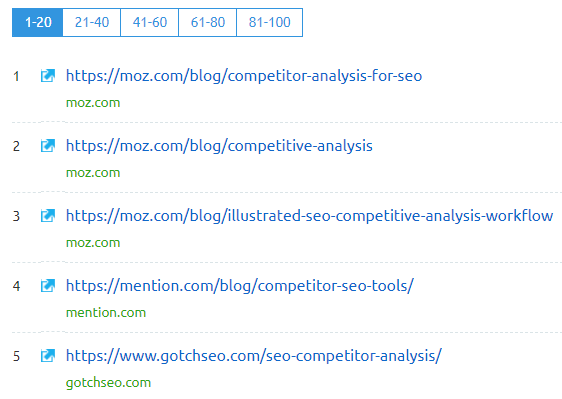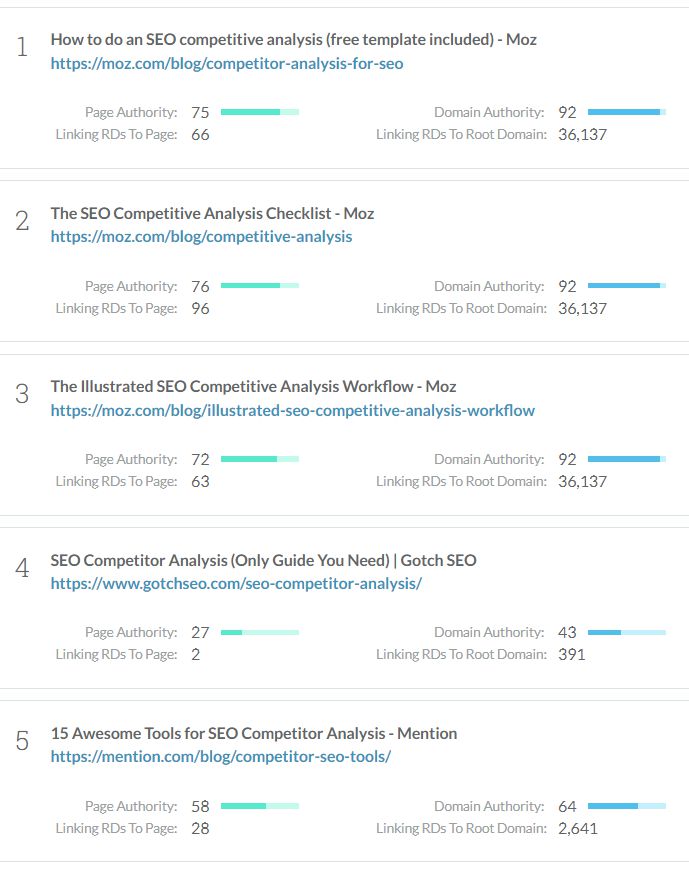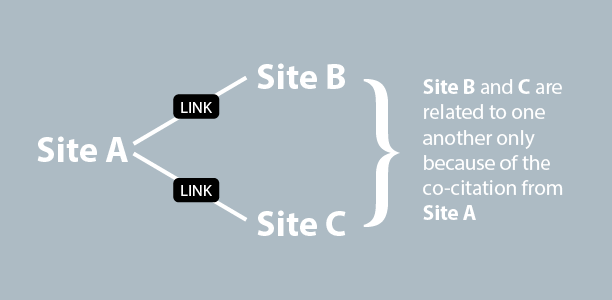Competitor analysis is a crucial component of any successful B2C and B2B SEO campaign, but carrying out an effective competitor analysis can be challenging. Having a clear understanding of who you’re going up against in organic search results is extremely important and it’s the first thing you need to do when conducting an SEO competitor analysis.

Let’s review how you should go about identifying your competitors.
Identify your competitors
Identifying your competitors can be difficult if you don’t have access to the right tools. Keep in mind that your competitors offline (direct business competitors) are oftentimes different than online organic search competitors. Also, your competitors will vary depending on which keyword you’re targeting (i.e. – competitor for keyword A might not be the same competitor for keyword B).
Moz and SEMrush are both great SEO tools you can use to help identify your organic search competitors. Both tools will show you the top organic search results in Google for a given keyword. For example, here are the top results for “SEO competitor analysis“.
SEMrush

Moz

Your focus should be on the top 5 – 10 organic search results. These are the competitors that you should be including in your SEO competitor analysis.
Now that you’ve identified your competitors let’s review what components you should research and analyze in your SEO competitor analysis.
On-page SEO components
On-page SEO is the practice of optimizing individual web pages in order to rank higher and earn more relevant traffic through search engines. Components of on-page SEO include anything that you can directly control on your own website. This includes page content, title tags, meta descriptions, URLs, page speed, internal linking structure, and site navigation structure just to name a few.
Page content
What type of page content is your competitor using? How much content is on the page (word count)? Are they using heading tags (h1, h2, h3 etc.) to break up content? How many times does your target keyword appear on their page? These are the questions you need to be asking yourself when analyzing your competitors’ content.
Title tags
Title tags are still one of the most influential ranking factors in today’s search landscape. It’s recommended that your target keyword be placed at the beginning of your title tag. Take a look at your competitors to see how they’re formatting their title tags, and be sure to take advantage of our Google SEO SERP Preview Tool to see how your listings will appear in Google’s search results.
Meta descriptions
According to Google, meta descriptions are not a ranking factor. However, they can help improve organic click-through rate (CTR). Thus, it’s important to see how your competitors are structuring their meta descriptions. Your meta descriptions should be compelling, and should make users want to click on your organic search listing.
Heading tags
Heading tags (h1, h2, h3 etc.) help search engines get a better understanding of what your page is about. They also help break up content making it easier for users to digest information on your page. It is recommended that your target keyword be placed within your h1 tag, as well as other heading tags when applicable.
URL structure
URLs are definitely a ranking factor. Search engines use words within URLs to help understand what a page is about. Thus, it’s important to include your target keyword within your URL. For example, if you’re targeting “SEO competitor analysis” then your page URL path may look something like this:
/seo-competitor-analysis
Internal linking
Many people forget about internal linking, and how important it is for SEO. Internal links help spread link equity throughout your site. Be sure to take a look at how your competitors are linking to their own pages. Ideally, your anchor text, or visible text within a hyperlink, should be keyword-rich and should link to relevant pages that you’re trying to rank.
Page speed
Page speed has become more and more significant in SEO over recent years. Google continues to emphasize the importance of having fast-loading pages, thus it’s not something to ignore. Use Google’s Page Speed Insights Tool to see how fast your pages loading and also get recommendations on what you can do to increase your page speed scores. Page speed is not something you can replicate from one of your competitors per-se, but it’s definitely worth noting how fast their pages are loading for peace of mind.
Site navigation structure
An optimized site navigation structure can absolutely have a positive impact on SEO. Ideally, your site navigation should include links to all important pages that you want to rank well in organic search. Review your competitors’ site navigation to see if you can pinpoint something they’re doing that you’re not.
Backlinks, linking root domains (LRDs), and domain authority (DA)
Backlinks, and more so Linking Root Domains (LRDs), are very important when it comes to SEO. A backlink is an incoming hyperlink from one web page to another website. Linking root domains are the total number of domains/sites that have backlinks pointing to your site. For example, if www.example.com has 50 backlinks from site A and 20 backlinks from site B, then www.example.com has a total of 70 backlinks from 2 linking root domains.
Domain Authority (DA) is a search engine ranking score developed by Moz that predicts how well a website will rank on search engine result pages (SERPs). Domain Authority is calculated by evaluating linking root domains and the number of total links. A Domain Authority score ranges from 1 – 100, with higher scores corresponding to a greater ability to rank.
Ideally, you want to acquire backlinks from relevant, high-authority and trustworthy sites. You’ll want to make sure you check your competitors’ backlinks to see if you can discover link opportunities for your own site. You can use Moz’s Open Site Explorer or SEMrush to conduct competitive backlink research. If one of your competitors’ Domain Authority is significantly higher than yours, and is outranking you, then chances are you need to acquire more high-quality backlinks for your site.
Co-citation and co-occurrence
In the SEO landscape, co-citation and co-occurrence refers to a site’s ability to rank with limited and/or zero link signals (backlinks). Co-citation and co-occurrence have not been confirmed as a ranking signal by Google, but many industry experts theorize that this is the next “big thing” in terms of how Google is going to rank web pages without relying on link metrics.
Co-citation

Co-citation is the presence of two different links, A and B, on a web page (C), meaning that the value of C will pass through equally to A and B. Co-citation also states that link A and B will establish an interrelationship and pass some value by association to each other. Essentially, co-citation establishes a connection between the A and B websites that are not directly linked to one another, but do exist together on web page C.
Co-occurrence

Co-occurrence is all about frequency and proximity associated with a keyword and a brand/company. Essentially, co-occurrence refers to the association of important keywords that are in close proximity with each other. If company A is trying to rank for “SEO competitor analysis” and Company A is frequently mentioned next to the term “SEO competitor analysis“, then that sends a signal to Google saying “these two keywords/terms are relevant to one another“.
You can determine your competitors’ co-occurrence authority by using advanced search operators. For example, put the following in Google search:
“your competitor brand name” “your target keyword”
This will show you all instances of where your competitor and target keyword are mentioned in the same content.
Create an SEO strategy using insights from your SEO competitor analysis
As you can see there’s a lot of moving parts to an SEO competitor analysis. Take your time and be thorough as you research your competitors. Once you’re finished you can develop an SEO strategy and action plan using the insights you gained.
Combat your competition and stay ahead of the game in organic search!
Don’t Miss a Beat!
Receive current information, expert advice, helpful tips, and more…
* Your privacy is important to us.
